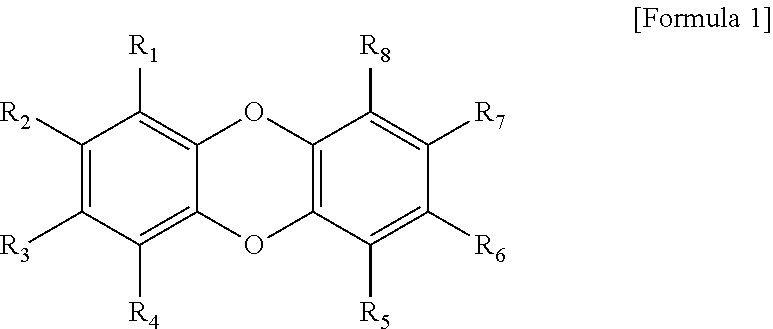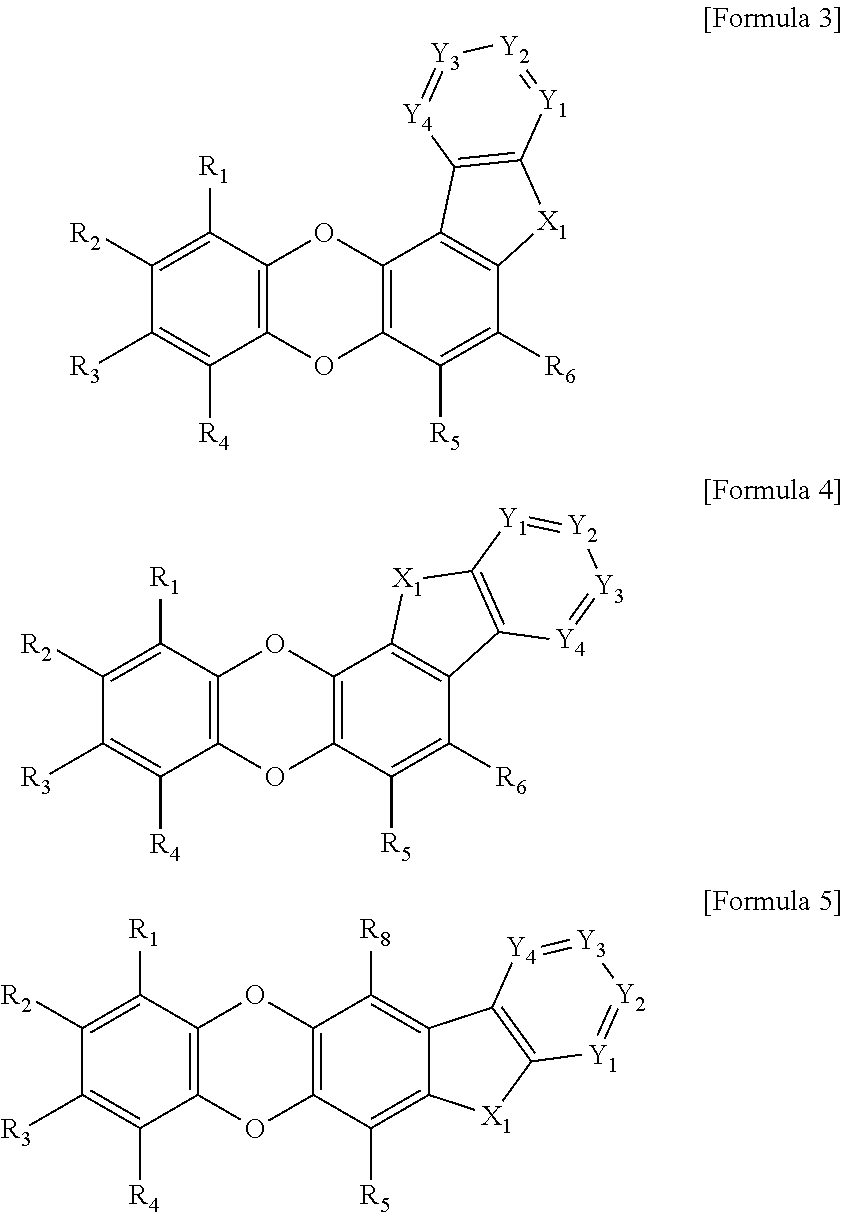Organic compound and organic electroluminescent element comprising same
a technology of organic compound and organic electroluminescent element, which is applied in the direction of luminescent compositions, organic chemistry, chemistry apparatus and processes, etc., can solve the problems of material failure to reach a satisfactory level, reduce the lifetime of the device, and the host energy gap is wide, so as to achieve the effect of improving the lifetime, excellent thermal stability, and improving the efficiency
- Summary
- Abstract
- Description
- Claims
- Application Information
AI Technical Summary
Benefits of technology
Problems solved by technology
Method used
Image
Examples
preparation example 2
Synthesis of Compounds Inv3 and Inv4
[0125]
Synthesis of 2-(dibenzo[b,e][1,4]dioxin-2-yl)-4,4,5,5-tetramethyl-1,3,2-dioxaborolane
[0126]2-bromodibenzo[b,e][1,4]dioxine (100 g, 0.38 mol), bis(pinacolato)diboron (115.8 g, 0.46 mol), Pd(dppf)Cl2 (31 g, 0.038 mol), and KOAc (111.9 g, 1.14 mol) were put into a flask, 1,4-dioxane (2 L) was added thereto to dissolve the mixture, and then the resulting solution was heated and stirred for 8 hours. After the reaction was terminated, distilled water was added thereto, and an organic layer was extracted with ethyl acetate. The obtained organic layer was dried over Na2SO4, distilled under reduced pressure, and then purified with column chromatography to obtain a compound 2-(dibenzo[b,e][1,4]dioxin-2-yl)-4,4,5,5-tetramethyl-1,3,2-dioxaborolane (73 g, yield 62%).
Synthesis of 2-(5-chloro-2-nitrophenyl)dibenzo[b,e][1,4]dioxine
[0127]The 2-(dibenzo[b,e][1,4]dioxin-2-yl)-4,4,5,5-tetramethyl-1,3,2-dioxaborolane (73 g, 0.235 mol) obtained in , 2-bromo-4-c...
preparation example 3
Synthesis of Compounds Inv5 and Inv6
[0129]
Synthesis of 2-(dibenzo[b,e][1,4]dioxin-2-yl)-4,4,5,5-tetramethyl-1,3,2-dioxaborolane
[0130]2-bromodibenzo[b,e][1,4]dioxine (100 g, 0.38 mol), bis(pinacolato)diboron (115.8 g, 0.46 mol), Pd(dppf)Cl2 (31 g, 0.038 mol), and KOAc (111.9 g, 1.14 mol) were put into a flask, 1,4-dioxane (2 L) was added thereto to dissolve the mixture, and then the resulting solution was heated and stirred for 8 hours. After the reaction was terminated, distilled water was added thereto, and an organic layer was extracted with ethyl acetate. The obtained organic layer was dried over Na2SO4, distilled under reduced pressure, and then purified with column chromatography to obtain a compound 2-(dibenzo[b,e][1,4]dioxin-2-yl)-4,4,5,5-tetramethyl-1,3,2-dioxaborolane (73 g, yield 62%).
Synthesis of 2-(4-chloro-2-nitrophenyl)dibenzo[b,e][1,4]dioxine
[0131]The 2-(dibenzo[b,e][1,4]dioxin-2-yl)-4,4,5,5-tetramethyl-1,3,2-dioxaborolane (73 g, 0.235 mol) obtained in , 1-bromo-4-c...
preparation example 4
Synthesis of Compounds Inv7 and Inv8
[0133]
Synthesis of 2-bromo-7-phenyldibenzo[b,e][1,4]dioxine
[0134]2,7-dibromodibenzo[b,e][1,4]dioxine (137 g, 0.400 mol), phenylboronic acid (49 g, 0.400 mol), and Pd(dppf)Cl2 (23.1 g, 0.02 mol) were put into a flask, a 2 M saturated aqueous solution of Na2CO3 (600 ml) and 1,4-dioxane (2 L) were added thereto to dissolve the mixture, and then the resulting solution was heated and stirred for 8 hours. After the reaction was terminated, distilled water was added thereto, and an organic layer was extracted with ethyl acetate. The obtained organic layer was dried over Na2SO4, distilled under reduced pressure, and then purified with column chromatography to obtain a compound 2-bromo-7-phenyldibenzo[b,e][1,4]dioxine (129 g, yield 95%).
Synthesis of 4,4,5,5-tetramethyl-2-(7-phenyldibenzo[b,e][1,4]dioxin-2-yl)-1,3,2-dioxaborolane
[0135]The 2-bromo-7-phenyldibenzo[b,e][1,4]dioxine (129 g, 0.38 mol) obtained in , bis(pinacolato)diboron (115.8 g, 0.46 mol), P...
PUM
 Login to View More
Login to View More Abstract
Description
Claims
Application Information
 Login to View More
Login to View More - R&D
- Intellectual Property
- Life Sciences
- Materials
- Tech Scout
- Unparalleled Data Quality
- Higher Quality Content
- 60% Fewer Hallucinations
Browse by: Latest US Patents, China's latest patents, Technical Efficacy Thesaurus, Application Domain, Technology Topic, Popular Technical Reports.
© 2025 PatSnap. All rights reserved.Legal|Privacy policy|Modern Slavery Act Transparency Statement|Sitemap|About US| Contact US: help@patsnap.com



